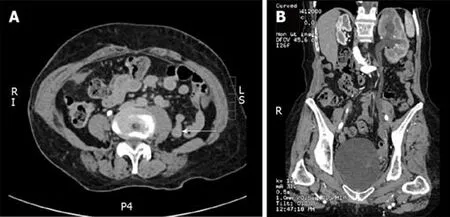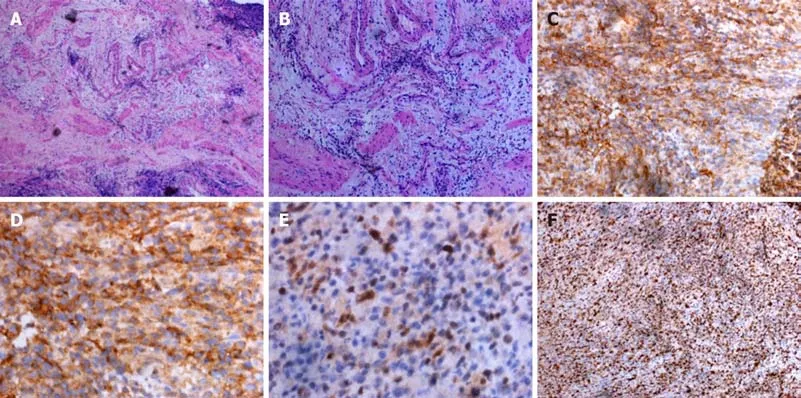Ureteral Ewing’s sarcoma in an elderly woman:A case report
Xin-Xin Li,Jian-Bin Bi
Xin-Xin Li,Jian-Bin Bi,Department of Urology,the First Hospital of China Medical University,Shenyang 110001,Liaoning Province,China
Abstract
Key words:Ewing’s sarcoma;Ureter;Elderly woman;Flank pain;Hematuria;Case report
INTRODUCTION
Ewing’s sarcoma(ES)is a rare malignant disease in which tumor cells are usually found in the bone or soft tissue and typically occurs between the ages of 10 years and 20 years[1].ES arises primarily from bone and is rarely of extra-skeletal origin[2].Of the extraosseous ES reported,to our knowledge ureteral(U)ES has only been noted in a 17-year-old girl[3].We present the clinical and pathologic features of an elderly woman who was diagnosed with UES and discuss the differences between this patient and the 17-year-old patient with UES.
CASE PRESENTATION
Chief complaints
A 69-year-old woman presented with a 10-d history of intermittent left flank pain.
History of present illness
Following impact,she felt frequent urination(five to six times in the day and three times in the night).Past medical history showed hematuria 1 year ago.
History of past illness
There were no significant comorbidities at admission.
Personal and family history
The patient was a non-smoker,without personal or family history of other diseases.
Physical examination upon admission
No obvious abnormalities in the physical examination.
Laboratory examinations
The results of laboratory studies showed poor renal function with increased creatinine(271 μmol/L)and urea(12.98 mmol/L).
Imaging examinations
Computed tomography(Figure 1)revealed a 1.5 cm soft tissue mass in the left ureteral pelvic segment with left hydronephrosis and ureter dilatation.
FINAL DIAGNOSIS
Histopathology examination(Figure 2)revealed a pT2N0M0 tumor 1.5 cm in size composed of small cells with indistinct cell borders,scant cytoplasm and atypia nuclei.Immunohistochemistry demonstrated that the tumor cells were positive for cluster of differentiation 99(CD99),transducin-like enhancer protein 1,and 70% were positive for Ki67.The pathology department of our hospital diagnosed it to be ES,with no metastasis of para-vascular lymph nodes.
TREATMENT
The patient underwent resection of the ureter lesion,end anastomosis and local lymph node dissection.
OUTCOME AND FOLLOW-UP
When taking into account the patient’s age and cardiopulmonary function,she was not treated with chemotherapy.Four weeks after surgery,her creatinine level was normal.Three months later,the patient underwent re-examination with computed tomography scans of the chest,abdomen and pelvis,and no recurrence or metastases were found.The patient is still alive.
DISCUSSION
ES is a rare entity.Similar to other sarcomas,ES is a monomorphic small round cell tumor that originates from the neural crest and accounts for 10% of all sarcomas[4].Individual cases of ES have been reported in almost all organs in the urinary system.

Figure 1 Preoperative computed tomography scanning.
Primary ES in the kidney was first reported by Moret al[5]in 1994,and this was the earliest discovery of ES in the urinary system.Over the past 15 years,the incidence of renal ES has steadily increased with over 100 cases reported in the literature[6],and Risiet al[7]noted 116 cases of renal ES.The majority of patients were men(55%),and the median age was 28.0 years(20.0-42.0 years).All patients had clinical symptoms as the initial presentation of disease.Pain was the most frequent symptom(54%),followed by hematuria(29%).The median overall survival(OS)was 26.5 mo.Thirtythree percent of these patients were found to have metastasis when the disease was diagnosed.The median OS of metastatic patients was 24 mo,and the three most frequent sites of metastases were lung(60%),liver(37%)and abdominal wall lymph nodes(20%).Patients with metastatic disease have more than a 4-fold increase in the relative risk of death compared to non-metastatic patients at diagnosis.
Of all the cases reported,89% of patients underwent surgery.The 2-year survival rate was 80% compared with 30% in those who did not undergo surgery.Half of patients also underwent preoperative or postoperative chemotherapy.The 12-mo OS was 93% compared to 75% in those who did not undergo chemotherapy.
The diagnosis of ES mainly depends on histopathology and immunohistochemistry of surgical specimens.ES cells are typically positive for CD99 and friend leukemia integration 1 transcription factor(FLI-1)in more than 90% of cases.CD99 has been found to be nonspecific in the diagnosis of ES;thus,the presence of other typical biomarkers including SYN(synaptophysin),FLI-1 and Ki67 should be determined[8,9].Clinically,renal ES patients treated with seven cycles of chemotherapy including vincristine,cyclophosphamide,dactinomycin and doxorubicin after radical nephrectomy remained disease-free for 7.5 years.Moreover,postoperative metastases to the liver and lymph nodes were treated with chemotherapy(six cycles of vincristine,doxorubicin and cyclophosphamide),and the response rate was approximately 90% based on the RECIST guidelines[10].
Lamet al[11]described a 31-year-old woman diagnosed with bladder ES who underwent complete resection of the bladder after 7 cycles of neoadjuvant chemotherapy,which reduced the size of the tumor from 8.1 cm to 2.5 cm,confirming the effectiveness of this therapeutic strategy.These authors also gathered information on all patients with bladder ES in the English literature.In these 13 cases with bladder ES,patient age ranged from 10 years to 81 years,with a mean age of 41 years.The most common presenting symptom was hematuria,followed by dysuria.Immunohistochemical findings showed that MIC2 was present in 100% of patients,whereas desmin was present in only 5 patients.This study also found that approximately 50% of patients had EWS/FLI-1 fusion following molecular genetics analysis.At the time of diagnosis,2 patients were identified as having metastases,including pulmonary and abdominal wall metastases.The treatment of bladder ES was based on the chemotherapy regimen used for ES[12].
According to the literature review,only 10 cases of prostate ES have been reported since 2003.The survival rate of these patients was 2 to 12 mo.The treatment strategy included surgery and adjuvant and neoadjuvant chemotherapy,but there was limited data acquisition[13].
ES occurring in the ureter was first reported in 2003 by Charnyet al[3]in a 17-yearold girl who presented with flank pain and hematuria.During surgery,a mass was excised from the wall of the right ureter followed by anastomosis of the ureter.The t(11;22)chromosomal translocation specific to ES was confirmed by reverse transcriptase polymerase chain reaction.Our patient was also diagnosed with UES.When comparing the two patients,our patient was older and did not fit into the typical age group for the occurrence of ES.Renal function in this patient was seriously impaired,and it was necessary to remove the obstruction,otherwise the patient would have developed renal failure.The previously reported case was discharged from hospital 4 days after surgery,and long-term follow-up information could not be obtained.Thus,the patient's surgical outcome could not be assessed.However,in our patient,postoperative renal function returned to normal,and no recurrence or metastases were found in the subsequent 6 mo.These findings confirmed that surgical resection was effective for the initial treatment of UES.The previously reported patient with UES was young,and her cardiopulmonary function allowed her to tolerate chemotherapy.However,as our patient was elderly,her physical condition prevented her from receiving other forms of treatment after surgery.Adjuvant chemotherapy may be beneficial in patients with ES occurring at other sites in the urinary system and may improve their survival time.

Figure 2 Microscopic and pathologic images.
CONCLUSION
We describe an extremely rare UES in an elderly woman treated with resection of the lesion and end anastomosis.Pathological analysis and immunohistochemistry of the surgical specimen were performed to confirm the diagnosis.Due to the rarity and malignancy of this tumor,early diagnosis and prompt surgical treatment are critical.
 World Journal of Clinical Cases2019年20期
World Journal of Clinical Cases2019年20期
- World Journal of Clinical Cases的其它文章
- Clinical use of low-dose aspirin for elders and sensitive subjects
- Distribution and drug resistance of pathogenic bacteria in emergency patients
- Comparative analysis of robotic vs laparoscopic radical hysterectomy for cervical cancer
- Feasibility of laparoscopic isolated caudate lobe resection for rare hepatic mesenchymal neoplasms
- Soft tissue release combined with joint-sparing osteotomy for treatment of cavovarus foot deformity in older children:Analysis of 21 cases
- Clinical characteristics of sentinel polyps and their correlation with proximal colon cancer:A retrospective observational study
